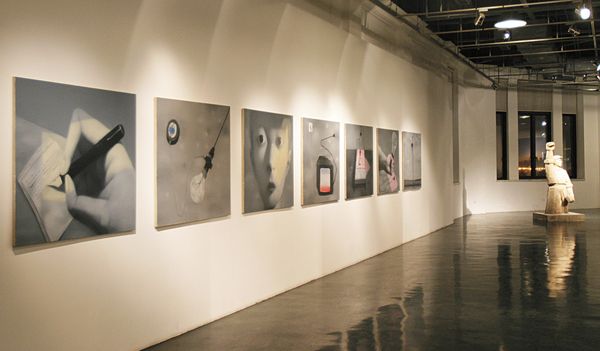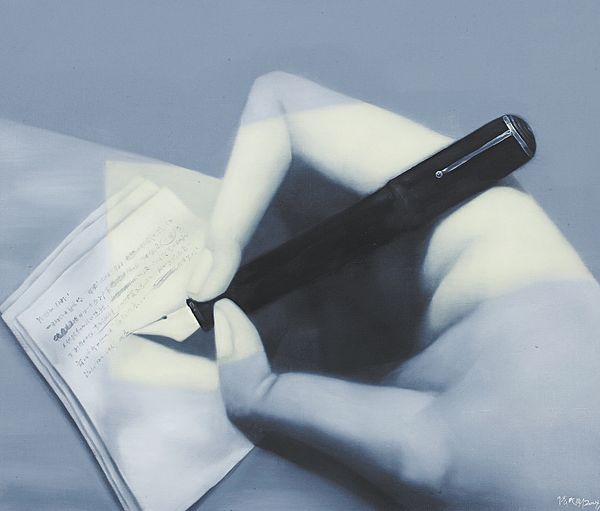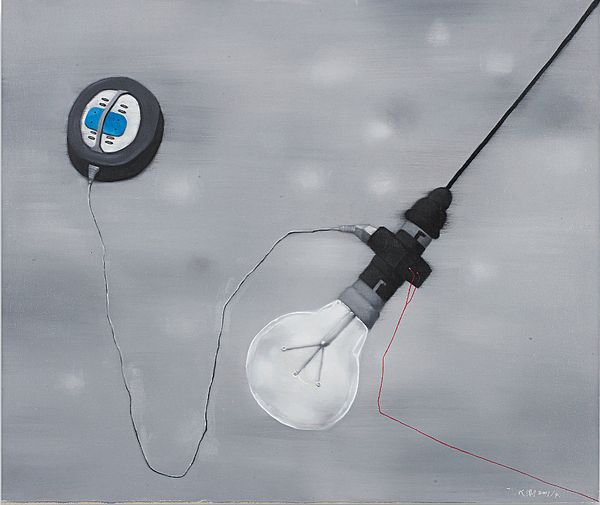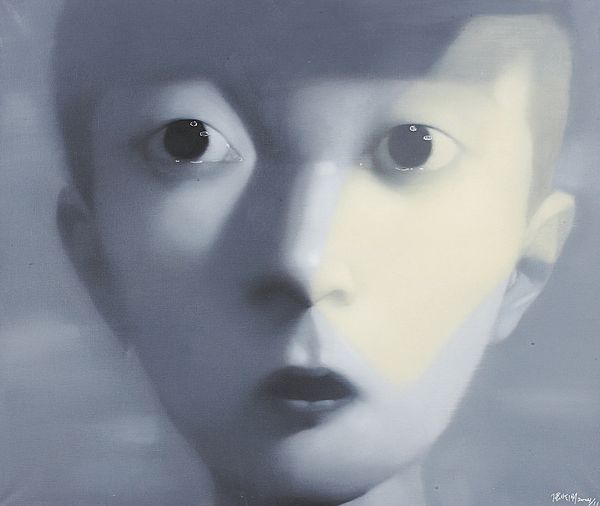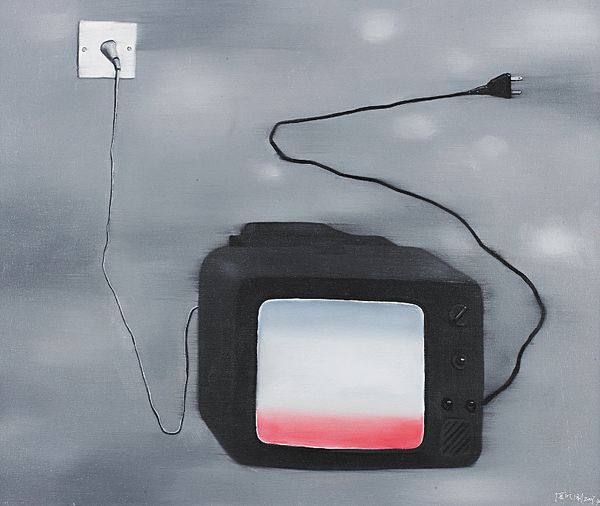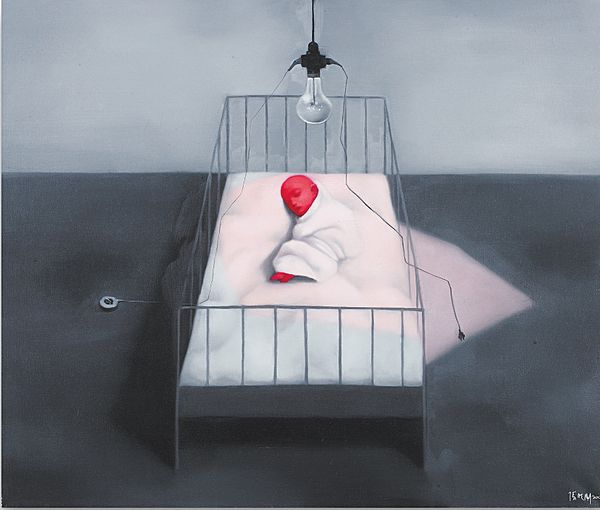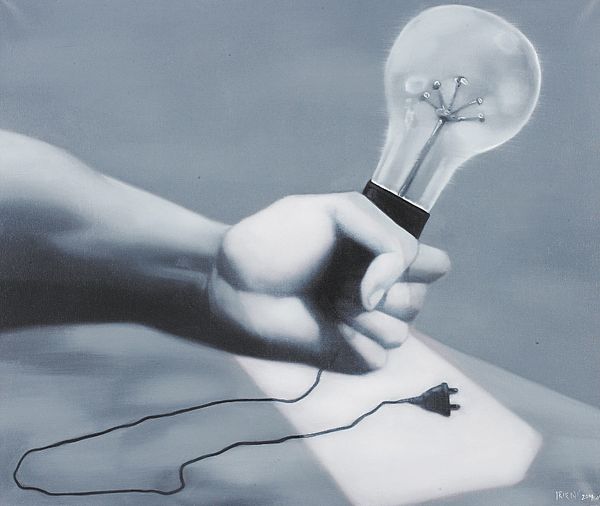Installation view of Amnesia and Memory (One Week), Shanghai Gallery of Art / Courtesy of Shanghai Gallery of Art
Zhang Xiaogang is internationally celebrated for his artistic commentary on the individual and collective character of contemporary Chinese memory. Born in 1958 in the province of Sichuan, he was an early progenitor of the 'Sichuan school' of painters. His 'Bloodlines' and 'Amnesia and Memory' series invoke traditional forms of twentieth-century Chinese studio portraiture, undercut with subtly harrowing stains and fissuring bloodlines that symbolize the random, underlying pressures of reality.
Amnesia and Memory (One Week) is a monumental work that comprises seven panels, one correlating to each day of the week. It is the first and only work of Zhang's to date that unites every important symbol of his art: the lightbulb, the haunting face with lustrous eyes, a hand inscribing an unseen text, the infant, the unplugged television set, a lone loudspeaker in a landscape, the disembodied hand grasping an unplugged lightbulb. The elements of this work extend beyond human portraiture to incorporate a medley of quotidian objects that summon up a surreal, half-remembered life. The work presents complete facets of the critical transition between Bloodlines and his later works, incorporating both portrait and landscape in a Symbolist fashion that places the viewer in a dreamlike sequence.
I don't want to plant a forest, but a single tree...I really have just one strand of thought and I dig deeper and deeper until I can't go any farther.
—Zhang Xiaogang
The core of the painting lies in its untold tale: Zhang's everyday objects, writ large, become imbued with a mysterious significance beyond themselves. Each scene is part of a story that has never been fully told, and never will be completely remembered. In this imagined fiction, amnesia becomes almost as important as memory. Like all of Zhang's work, the personal is also political. Once dubbed "China's hottest artist" by England's The Times, Zhang told the publication in 2008, "Sometimes an ancient building that has existed for thousands of years gets in the way of a road and it just disappears...In China history is like water, it flows and disappears."
In this vein, Zhang's constant repetition of a series of quotidian motifs attempts to mine his own memory as well as that of the collective consciousness. "I don't want to plant a forest, but a single tree that I hope will grow to be very big. I really have just one strand of thought and I dig deeper and deeper until I can't go any farther." Amnesia and Memory (One Week) is the monumental culmination of Zhang's exploration of history and its telling: a poignant commentary on the sirens and shadows that float just beneath the surfaces of our daydreams.
The Diary
"It was how my life was originally. At night when I didn't have a TV, I would write letters or write in my diary to pass the time. It’s a very isolated lifestyle." —Zhang Xiaogang, interview with Anjali Rao, CNN Talk Asia
The Light Bulb
The light bulb draws a long line of reference from Artschwager and Johns. In Zhang's work the bulb represents an aborted or dormant potential — the bulbs are frequently unplugged but radiant with potential energy.
The Face
Zhang's portraits of anonymous portrait sitters gained worldwide acclaim for their haunted stares and random and colored patches: "It's like a light hitting the person's face, and slowly it becomes a scar that time leaves behind." —Anjali Rao, CNN Talk Asia
The Television Set
The television set in Zhang's work broadcasts both information and propaganda, metaphors for amnesia and memory. It is also a symbol of economic progress in China: ownership of a television was a prized dream not so long ago for many families, and sometimes that set would serve as the information lifeline for an entire village. On the other hand, the lion's share of content is state-controlled, but its significance cannot be underestimated in the age of mass media.
The Red Baby
The red baby has been a central symbol of Zhang's work since 1993. He put all his secrets into it. All the memories of his childhood, buried for nearly two decades, came flooding back. The infant symbolizes several contradictory elements of modern China: the political overtones of Communist Red versus the color of Confucian blood ties, and the harsh one-child policy versus an affirmative symbol of life.
Fist and Light Bulb
A clenched fist typically represents a resolute gesture of rebellion and was a popular symbol in socialist propaganda art. Within Zhang's art, the political connotation is less obvious, but the strength of the sinewy arm clenching the unplugged lightbulb imparts a purposeful bent. Like the diary and television set, the unplugged bulb represents both potential energy and its imminent interruption.
The Loudspeaker
The loudspeaker shows up in several paintings in the Amnesia and Memory series. Zhang remembers these as an integral part of his childhood years, exiled to a village where loudspeakers bellowing out music and state propaganda were the only entertainment.
"There was nothing else to hear, no other choice." —Zhang Xiaogang, quoted in Jane McCartney's "Meet Zhang Xiaogang, China's Hottest Artist"
